| |||||
| Decades: | |||||
|---|---|---|---|---|---|
| See also: | Other events of 1800 List of years in Austria | ||||
Events from the year 1800 in Austria
| |||||
| Decades: | |||||
|---|---|---|---|---|---|
| See also: | Other events of 1800 List of years in Austria | ||||
Events from the year 1800 in Austria
| | This section needs expansion. You can help by adding to it. (October 2015) |
| | This section needs expansion. You can help by adding to it. (October 2015) |
| | This section needs expansion. You can help by adding to it. (October 2015) |

Franz Joseph I or Francis Joseph I was Emperor of Austria, King of Hungary, and the ruler of the other states of the Habsburg monarchy from 2 December 1848 until his death on 21 November 1916. In the early part of his reign, his realms and territories were referred to as the Austrian Empire, but were reconstituted as the dual monarchy of the Austro-Hungarian Empire in 1867. From 1 May 1850 to 24 August 1866, he was also president of the German Confederation.

Charles I or Karl I was Emperor of Austria, King of Hungary, King of Croatia, King of Bohemia, and the last of the monarchs belonging to the House of Habsburg-Lorraine to rule over Austria-Hungary. The son of Archduke Otto of Austria and Princess Maria Josepha of Saxony, Charles became heir presumptive of Emperor Franz Joseph when his uncle Archduke Franz Ferdinand of Austria was assassinated in 1914. In 1911, he married Princess Zita of Bourbon-Parma. He is venerated in the Catholic Church, having been beatified by Pope John Paul II on 3 October 2004, and is known to the Catholic Church as Blessed Karl of Austria.
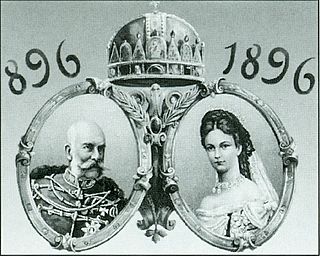
Kaiser is the German word for "emperor". In general, the German title in principle applies to rulers anywhere in the world above the rank of king (König). In English, the (untranslated) word Kaiser is mainly applied to the emperors of the unified German Empire (1871–1918) and the emperors of the Austrian Empire (1804–1918). During the First World War, anti-German sentiment was at its zenith; the term Kaiser—especially as applied to Wilhelm II, German Emperor—thus gained considerable negative connotations in English-speaking countries.

The House of Kinsky is a prominent Czech noble family originating from the Kingdom of Bohemia. During the Thirty Years' War, the Kinsky family rose from minor nobles to comital (1628) and later princely status (1747) under the rule of the Habsburgs. The family, recorded in the Almanach de Gotha, is considered to have been one of the most illustrious of Austria-Hungary.
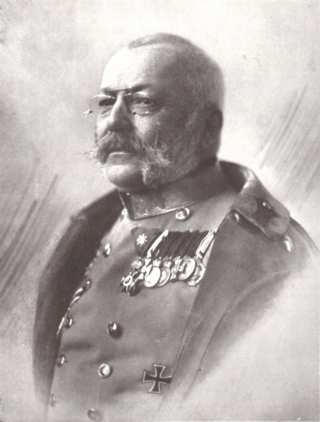
Archduke Friedrich, Duke of Teschen was a member of the House of Habsburg and the supreme commander of the Austro-Hungarian Army during World War I.

The House of Lorraine originated as a cadet branch of the House of Metz. It inherited the Duchy of Lorraine in 1473 after the death without a male heir of Nicholas I, Duke of Lorraine. By the marriage of Francis of Lorraine to Maria Theresa of Austria in 1736, and with the success in the ensuing War of the Austrian Succession (1740–1748), the House of Lorraine was joined to the House of Habsburg and became known as the House of Habsburg-Lorraine. Francis, his sons Joseph II and Leopold II, and his grandson Francis II were the last four Holy Roman emperors from 1745 until the dissolution of the empire in 1806. The House of Habsburg-Lorraine inherited the Habsburg Empire, ruling the Austrian Empire and then Austria-Hungary until the dissolution of the monarchy in 1918.
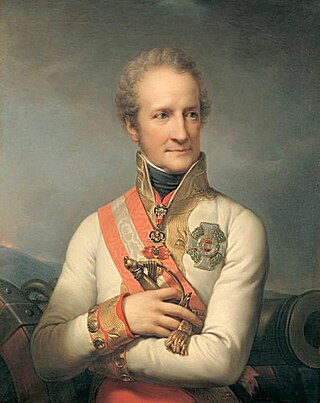
Johann I Joseph was Prince of Liechtenstein between 1805 and 1806 and again from 1814 until 1836. He was the last Liechtenstein prince to rule under the Holy Roman Empire between 1805 and 1806 and as regent of Liechtenstein from 1806 until 1814. He was the fourth son of Franz Joseph I, Prince of Liechtenstein.
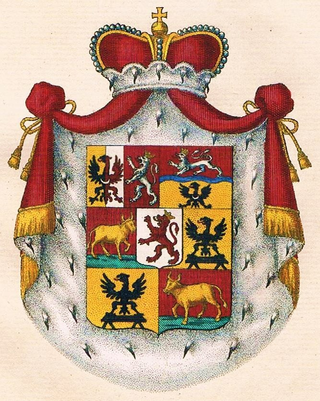
The House of Auersperg is an Austrian princely family, which once held estates in the Holy Roman Empire. The princely family of Auersperg originated as a junior branch of the comital line of Auersperg from Carniola, one of the hereditary Habsburg duchies in what is now Slovenia. The Auerspergs were raised to princely status in 1653, and they became "immediate" princes of the Holy Roman Empire in 1664. The princes of Auersperg also held at various times the duchies of Münsterberg and Gottschee. Their territories were mediatised by Austria and Baden in 1806, and the family is counted as high nobility.

The Military Order of Maria Theresa was the highest military honour of the Habsburg monarchy, Austrian Empire and Austro-Hungarian Empire.
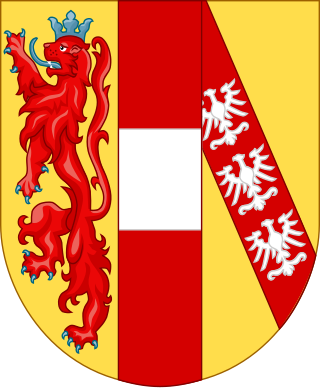
The House of Habsburg-Lorraine originated from the marriage in 1736 of Francis III, Duke of Lorraine and Bar, and Maria Theresa of Austria, later successively Queen of Bohemia, Queen of Hungary, Queen of Croatia and Archduchess of Austria. Its members are the legitimate surviving line of both the House of Habsburg and the House of Lorraine and inherit their patrimonial possessions and vocation to the Empire from their female line of the House of Habsburg and from the male line of the House of Lorraine.

Franz, Prince of Bavaria was a member of the Bavarian Royal House of Wittelsbach and a Major General in the Bavarian Army.

Infanta Maria Theresa of Portugal was a Princess of the House of Braganza. She became by marriage an Archduchess of Austria and also sister-in-law of Emperors Franz Joseph I of Austria and Maximilian I of Mexico, as well as step-grandmother of Emperor Charles I of Austria.

Archduchess Elisabeth Amalie of Austria was a daughter of Archduke Karl Ludwig of Austria and his third wife Infanta Maria Theresa of Portugal. She was the mother of Franz Joseph II, Prince of Liechtenstein, and the paternal grandmother of Hans-Adam II, Prince of Liechtenstein.
Franz is a German name and cognate of the given name Francis. Notable people named Franz include:
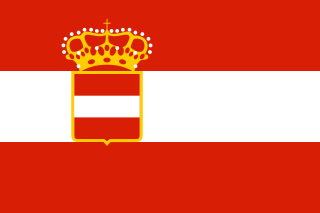
The Supreme Commander of the Imperial and Royal Armed Forces was the ultimate authority of the Austro-Hungarian Armed Forces – which comprised the Army, Navy and Aviation Troops of Austria-Hungary.

The leaders of the Central Powers of World War I were the political or military figures who commanded or supported the Central Powers.

The Kaiser Franz Joseph I class was a class of two protected cruisers built for the Austro-Hungarian Navy. Named for Austro-Hungarian Emperor Franz Joseph I, the class comprised SMS Kaiser Franz Joseph I and SMS Kaiserin Elisabeth. Construction took place throughout the late 1880s, with both ships being laid down in 1888. Kaiser Franz Joseph I was built by Stabilimento Tecnico Triestino in Trieste, while Kaiserin Elisabeth was built at the Pola Navy Yard in Pola. The Kaiser Franz Joseph I-class ships were the first protected cruisers constructed by the Austro-Hungarian Navy. Kaiser Franz Joseph I was the first ship of the class to be commissioned into the fleet in July 1890. She was followed by Kaiserin Elisabeth in November 1892.

SMS Kaiser Franz Joseph I was a protected cruiser built for the Austro-Hungarian Navy. Named for the Austrian emperor and Hungarian king Franz Joseph I, Kaiser Franz Joseph I was the lead ship of her namesake class. Constructed by Stabilimento Tecnico Triestino in Trieste, she was laid down in January 1888 and launched in May 1889. Kaiser Franz Joseph I was commissioned into the Navy in June 1890. As the first protected cruiser constructed by the Austro-Hungarian Navy, she was intended to serve as Austria-Hungary's response to the Italian cruisers Giovanni Bausan and Etna. Her design was heavily influenced by the Jeune École, a naval strategy which had gained prominence in the 1880s as a means to combat a larger and more heavily armored navy of battleships through the use of torpedo flotillas.
![]() Media related to 1800 in Austria at Wikimedia Commons
Media related to 1800 in Austria at Wikimedia Commons